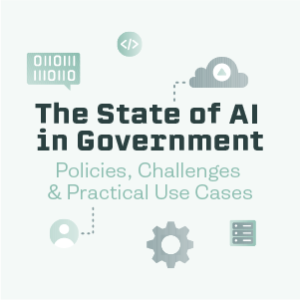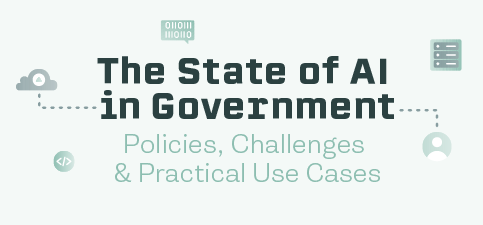Government agencies have been discussing artificial intelligence (AI) for more than a decade, and as technology and legislation progress, the focus on public sector impacts is stronger than ever. A 2019 executive order highlights American leadership in AI as key to maintaining the economic and national security of the United States. The Trump administration has also issued regulatory guidance on AI, instructing all federal agencies to prioritize and allocate funding for AI programs that serve their individual missions. Numerous national agencies and even multinational partnerships have identified AI as a priority. AI’s similarity to human intelligence means it could potentially impact every corner of society, from cybersecurity to medicine. To learn more about how your agency can use AI to analyze data, recognize patterns and automate manual tasks, get up to date with The State of AI in Government, a guide created by GovLoop and Carahsoft featuring insights from the following technology and government AI thought leaders.
AI Requires a New Approach to High-Performance Computing
“High-performance computing (HPC) needs to evolve. The traditional HPC architecture, now decades old, worked well for previous generations of HPC applications. But today’s applications, driven by AI, require a new approach. The problem? The old systems were too static. That wasn’t a problem when applications had static performance requirements. But AI is different. When developing an AI system, the workload changes from one stage of the process to another.”
Read more insights from Liqid’s Public Sector Chief Technology Officer, Matt Demas, and Director of Sales, Eric Oberhofer.
Bring AI to the Edge
“Legacy computing structures always glued data scientists to data centers. The two were tethered together, meaning scientists couldn’t work where the data didn’t reside, much like how a lab scientist needs their lab chemicals and instruments. Data science, however, is not entirely like lab science, because endless inputs come outside of a controlled environment. AI models are most effective when exposed to open air. The solution is to bring software-based applications to the edge, except for massive data projects.”
Read more insights from HPE’s Defense Department Account Team Technologist, Jeff Winterich, and Red Hat’s Public Sector Staff Solutions Architect, Ryan Kraus.
 3 Ways Cloud Improves AI
3 Ways Cloud Improves AI
“Cloud-based AI can help agencies move faster. During the pandemic, it has. One example is automating document workflows so that AI replaces manual data entry and extracts metadata to enhance search capabilities. As a result, AI speeds up timelines for constituents. Without having to wait on employees to manually enter data or respond to simple queries, citizens receive the front-facing information and services they need faster. Agencies can build AI faster in the cloud, too. Developers access capabilities through simple application programming channels, so they don’t have to build or integrate models from scratch. Cloud services like Amazon SageMaker remove the busywork and infrastructure so that data science teams are more productive and efficient when rolling out [machine learning].”
Read more insights from AWS’s Tech Business Development Manager of AI and ML for the Worldwide Public Sector, Joe Pringle.
How AI Demands a New Vision of the Data Center
“Technology originally developed to improve PC-based gaming and multimedia applications nearly 30 years ago is now driving advances in the field of artificial intelligence. In the early 1990s, when PC gaming was beginning to take off, the Graphics Processing Unit (GPU) was invented by NVIDIA to render an image by breaking it up into multiple tasks that could be executed in parallel. Today, the same approach accelerates processing for a wide range of applications, not just on PCs but also on the world’s fastest computers.”
Read more insights from NVIDIA’s Vice President of the GPU Data Center Architect, Curt Smith.
DoD’s Battle Against COVID-19, With AI at the Helm
“When you’re talking about a domestic threat like COVID-19, for us to, for instance, predict how COVID-19 is going to be affecting a certain military installation, you might need data from things that would be nontraditional DoD data. So, you might need data from CDC, [or] from Department of Labor when it comes to unemployment. So, these sorts of datasets I think are really hard for the DoD to have, because they’re not traditional military data. But at the same time, for us to do accurate modeling, we do need datasets like that. So, this project had a lot more sort of rigorous policy review for data, more so than a project like predictive maintenance, for instance.”
Read more insights from Chief of Policy at the Department of Defense’s Joint Artificial Intelligence Center, Sunmin Kim.
Using AI to Improve Veteran Care and Save Lives
“It’s been an amazing journey from a veterans’ experience perspective. The Veterans Experience Office came out of the crisis of Phoenix, when there were the issues with the lists of appointments and veterans were not getting timely appointments – and the data was showing things differently. We did not have the customer datasets. We had a lot of operational data, we had a lot of financial data, but we did not have necessarily the data for [customers]. And I think that from the customer perspective, I think that’s a key aspect with AI. You can’t have AI if you don’t have the right data in place … and that’s something the VA has been very diligently working on.”
Read more insights from Department of Veterans’ Affairs Chief of Staff at the time of the interview, Lee Becker; Director of Enterprise Measurement, Anil Tilbe; and Acting Executive Director of Multichannel Technologies, Laura Prietula.
Improving Public Health Through AI
“Traditionally, public health plays the role of a data aggregator. We’re collecting large volumes of information because we’re interested in understanding how often illnesses or injuries occur, not just at an individual level, but across entire communities or entire populations as a country at large. And we use that information to try to understand why those diseases or injuries occur, and then we use that to take action that will allow us to address really significant threats to the public health at their source. AI can play a role at many different places in that information chain.”
Read more insights from the Centers for Disease Control and Prevention’s Entrepreneur in Residence, Paula Braun.
Download the full GovLoop Guide for more insights from these artificial intelligence thought leaders and additional interviews, historical perspectives and industry research on the future of AI.







